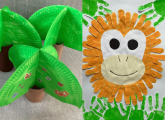Children find the process of using magnets fascinating. However, they can also be harnessed to support a host of creative learning opportunities, says Laura Moore…
Children are born with a natural desire to figure out how the world works, and magnets are guaranteed to appeal to their curiosity. They’re a fantastic resource for any early years setting because they allow children to explore scientific properties in a way that’s simple but which also prompts plenty of questioning and develops understanding.
Below are five open-ended learning opportunities that are quick, easy to implement and challenging for children of all abilities…
This one’s simple. Provide the children with metal stars, iron filing cases, magnet rings and magnet wands, and watch as they learn…
This fun activity encourages children to find out about the fascinating properties of magnets and magnetic materials. It’s a simple, practical opportunity to explore the idea that magnets attract and repel other magnets and attract magnetic substances.
Extend children’s learning by offering them the chance to sort a variety of materials into two groups – magnetic and non-magnetic. A large tray on top of a table, with labelled jars to store sorted items, is perfect for this.
Put any (age- and stage-appropriate) items you can find into the tray with some horseshoe magnets and listen to the language used as children discuss their ideas.
Play ‘go fish phonics’ with magnetic ‘fishing rods’ – great when children are learning initial letter sounds and letter names.
As they fish the letters from a bowl, encourage them to say the sound and/or name of the letters they’ve caught.
Extension: add a sand timer – how many can you catch and read in a minute?
Using Numicon, magnet wands and magnetic balls, children can ‘catch’ the balls on the wand and count how many they have by using the Numicon shapes to help.
This promotes learning on 1:1 correspondence and the value of numbers. By providing numbers, children can then match the numeral to the quantity.
Extension: build upon addition facts, for example, “1+2+3=6, I have 6 in total.”
By the end of Reception, children should be able to read and write some common exception words. Using the first 45 high-frequency words on magnets alongside magnet wands, encourage the children to ‘catch’ a word, read it, record themselves saying it on a Talkboard, and try to write it without looking.
Extension: put the word in a sentence, record it and then write it.
For more great ideas and inspiration, follow Laura on Instagram at @lauraloveslearning.

Nature crafts – Make your own rainforest
Editors picks

Autism in Early Years – 8 ways to support children
Editors picks
